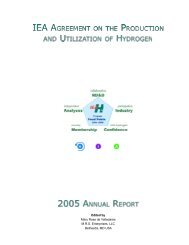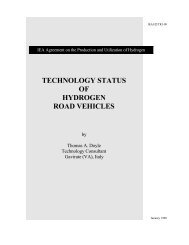Review of Small Stationary Reformers for Hydrogen Production
Review of Small Stationary Reformers for Hydrogen Production
Review of Small Stationary Reformers for Hydrogen Production
You also want an ePaper? Increase the reach of your titles
YUMPU automatically turns print PDFs into web optimized ePapers that Google loves.
� <strong>Hydrogen</strong> from chemical industry sources (e.g. excess capacity in ammonia plants,<br />
refineries which have recently upgraded their hydrogen production capacity, etc.)<br />
� <strong>Hydrogen</strong> produced at the refueling station via small scale steam re<strong>for</strong>ming <strong>of</strong> natural gas,<br />
or by re<strong>for</strong>ming <strong>of</strong> a more readily available liquid “hydrogen carrier” such as methanol or<br />
ammonia<br />
� <strong>Hydrogen</strong> produced via small-scale water electrolysis at the refueling station.<br />
In the longer term (Figure 2), hydrogen might be produced via<br />
� Gasification <strong>of</strong> coal, biomass or wastes<br />
� Electrolysis powered by wind or solar electricity<br />
� Thermochemical production from fossil fuels with CO2 capture and sequestration.<br />
Recently, several studies have assessed the cost and feasibility <strong>of</strong> building a hydrogen-refueling<br />
infrastructure <strong>for</strong> vehicles (Ogden et al. 1995; Ogden et al. 1996; Ogden et al. 1998; Ogden<br />
1999a. Ogden 1999b, Directed Technologies, Inc. (DTI) et al. 1997; Thomas et al. 1998a;<br />
Moore 1996; Raman 1996; Halvorson et al. 1996, Ferrell et al. 1996, Fairlie 1996, Thomas et al.<br />
1998b, Mark 1997). We summarize the results from two groups that have carried out<br />
comprehensive studies <strong>of</strong> hydrogen infrastructure: Princeton University’s Center <strong>for</strong> Energy and<br />
Environmental Studies (this work was directed by the author <strong>of</strong> this report) and Directed<br />
Technologies, Inc., an engineering consulting company that worked with Ford Motor Company<br />
to develop estimates <strong>of</strong> hydrogen infrastructure costs.<br />
The cost <strong>of</strong> supplying hydrogen to vehicles depends on a host <strong>of</strong> factors including the local<br />
energy prices, and the size <strong>of</strong> the hydrogen demand.<br />
For refueling stations designed to dispense 0.1 to 1.0 million scf H2/day (serving a fleet <strong>of</strong> 14-<br />
280 PEMFC buses or 900-9000 PEMFC cars), studies by researchers at Princeton University’s<br />
Center <strong>for</strong> Energy and Environmental Studies (Ogden et al. 1995, Ogden 1999a, Ogden 1999b),<br />
suggest that small-scale steam re<strong>for</strong>ming <strong>of</strong> natural gas at the refueling station might <strong>of</strong>fer the<br />
lowest delivered hydrogen cost, <strong>for</strong> energy prices typical <strong>of</strong> the United States. Delivered costs<br />
<strong>for</strong> hydrogen from onsite small-scale steam re<strong>for</strong>ming are found to be $12-$25/GJ, depending<br />
on the size <strong>of</strong> the refueling station (see Figure 3). For typical U.S. energy prices, distributed<br />
hydrogen production via steam re<strong>for</strong>ming gives the lowest delivered hydrogen cost until a large,<br />
geographically concentrated demand <strong>for</strong> hydrogen has built up (say about 3000 cars/sq. mile,<br />
an amount equal to about 20% <strong>of</strong> the cars in Los Angeles). In the early stages <strong>of</strong> a hydrogen<br />
economy distributed production <strong>of</strong> hydrogen would be preferred. This is also shown in Figure 4,<br />
where the infrastructure capital cost per car is illustrated.<br />
Similar results were found in recent studies conducted by Directed Technologies, Inc. (DTI et al.<br />
1997, Thomas et al. 1998). These studies were supported by Ford Motor Company and the<br />
United States Department <strong>of</strong> Energy (USDOE) and were coordinated by Directed Technologies,<br />
Inc., as part <strong>of</strong> the Partnership <strong>for</strong> a New Generation <strong>of</strong> Vehicles (PNGV) program. In this study,<br />
four major industrial hydrogen gas companies (Air Products and Chemicals, Inc., BOC Gases,<br />
Praxair and Electrolyser Corporation) carried out conceptual designs <strong>for</strong> hydrogen refueling<br />
infrastructure. The results <strong>of</strong> DTI’s studies are consistent with Princeton’s results. For<br />
example, in recent paper (Thomas et al. 1998) summarizing earlier studies, DTI researchers<br />
5













